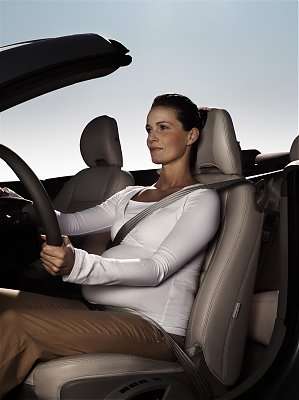|
| |||||
|
Safety For The Pregnant Driver And Her Unborn Child
23rd May, 2007 | ||||
|
If a pregnant woman uses her safety belt correctly, the foetal injury risk is reduced significantly.
Virtual pregnant crash test dummy Volvo Cars contributes to increasing the awareness of safety for pregnant drivers and knowledge of how to protect their unborn babies. One innovation in this field is a virtual pregnant crash test dummy. The model can be used to simulate how a pregnant woman moves in a crash and how the foetus moves inside her. The virtual pregnant crash test dummy's proportions correspond to those of an average sized woman in the final stage of pregnancy, approximately week 36. The virtual crash test dummy is used to simulate impact tests in frontal collisions. "The computer model makes it possible to study in detail how the occupant moves and how the safety belt and airbag affect the woman and the foetus, including surrounding structures," says Lotta Jakobsson, Child Safety Specialist at Volvo Cars. "This means that the engineers can simulate the impact on mother and unborn baby in collisions at different speeds and use the model to test for example safety belt designs under development." Pregnant women should always wear a safety belt It is always better to wear a safety belt than not to and pregnant women, like
everyone else, should make sure to always buckle up correctly. Here is how:
The positioning of the safety belt is important to ensure the occupant is restrained over the body's stronger areas - like the upper torso and pelvis - thus protecting the weaker parts of the body, such as the soft abdomen containing the fragile foetus. Studies on the virtual pregnant crash test dummy show that the driver airbag offers protection for both the mother and the foetus. Common injuries for unborn babies and their mothers Injuries unique to pregnant occupants involved in crashes include placental abruption, uterine rupture or laceration and direct foetal injury. The most common type of injury is a separated placenta. The placenta then becomes partially or completely detached, meaning that the baby can not get enough oxygen and nutrients, which can be fatal for the unborn baby. "Our research shows that the best protection for pregnant women and their unborn babies is for the mother to wear her three-point safety belt and to wear it properly. This reduces the foetal injury risk significantly," says Lotta Jakobsson. How to fasten the safety belt when you are pregnant
Potential injury risks for unborn babies in car crashes Non-fatal but possible long-term consequences
Fatal
The virtual pregnant crash test dummy The finite element model known as the virtual pregnant crash test dummy was developed by Volvo Cars, the first dummy of its kind. The model contains layer upon layer with detailed information about the uterus, placenta, amniotic fluid and foetus in approximately the 36th week of pregnancy. The dummy can be positioned in any car model and simulate collisions at different speeds. This has brought Volvo Cars to the important conclusion that pregnant women must always wear the safety belt and to wear it correctly. Volvo Cars has also concluded that pregnant women are better protected in frontal impacts with an airbag in the steering wheel than without the airbag. | |||||
ABN 47106248033 |
 |
All rights reserved. |
